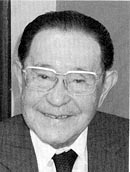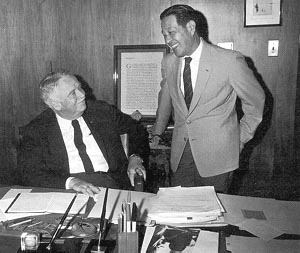Binational Research Institute Presaged by Darling
by Hiroshi Maki
ABCC Associate Director, and JNIH Hiroshima Branch Laboratory Director, 1948-75

Maki at RERF’s 15th anniversary in 1990.
George B Darling was appointed director of ABCC in 1957. No sooner did Dr and Mrs Darling arrive in Japan than the couple was invited to the annual meeting of the Nihon Society of Radiology (in Sapporo) through the courtesy of Masanori Nakaidzumi, former dean, Faculty of Medicine, University of Tokyo. For Darling to have met, on the occasion, a great many distinguished radiologists from the universities and research institutes in Japan must have helped ABCC in many ways in the years to come. Although the trip was for only a week, it offered the two an opportunity to savor the country and its people.
Community relations strengthened
The early directors of ABCC were all very concerned about the feelings of the community toward ABCC. Darling, in particular, attached great importance to the feeling of the study participants, exposed or nonexposed. He appreciated their understanding and cooperation and always took heed of their well-being. I believe that he had a deep understanding of the customs and feelings of the Japanese. This could be seen from the interest he had in upholding the solemnity of the autopsy room. He held memorial services for the autopsied to show his respect and he visited the homes of the aged study participants to celebrate their longevity.
Time and again, Darling appealed to the government offices, universities, institutes, and public hospitals in Hiroshima and Nagasaki for their cooperation in the ABCC-JNIH collaborative studies, and he welcomed their suggestions. He earned greater acceptance from the Japanese, which, I believe, was the fruit of his ceaseless efforts.
Perhaps due to Darling’s enthusiasm for the JNIH-ABCC program, the Darlings stayed in Japan for about 15 years. There is no doubt that Darling’s long tenure provided continuity and improved US-Japan relations. The Darlings were interested in Japanese culture and traveled extensively throughout the country. Darling enjoyed haiku poetry, and Mrs Darling had a great interest in the tea ceremony and pottery.
Resources in Japan promoted
I greatly admired the efforts Dr Darling made to arrange for the transfer of the ABCC pathology specimens–including those collected in the earlier years–from the Armed Forces Institute of Pathology in Washington to the A-bomb Medical Records and Specimens Center of Hiroshima University and to Nagasaki University.
He also worked hard to obtain funds from the US government to build hospitals for Hiroshima and Nagasaki universities.
In the introduction to the 1967-68 annual report, Darling wrote that, pending the 20th anniversary of ABCC, it would be timely for the Japanese and American governments to officially review ABCC. He expressed hope that the appropriate authorities of the US government would invite the views of the Japanese government on program priorities, administrative structure, staffing, and the financing of ABCC. Darling was also a proponent of a new joint agreement to ensure the continuation of scientifically promising studies for another 20 years. He suggested that ABCC be reorganized as a juridical person under Japanese law and that responsibility for professional direction, staffing, and financial support be redistributed. As it turned out, Darling’s concepts provided the basis for establishing the Radiation Effects Research Foundation in 1975.
In 1972, Darling retired and returned to the US. He was succeeded by LeRoy R Allen.

Darling, left, and the author in June 1970, five years before the establishment of the Radiation Effects Research Foundation.
As ABCC director, George Darling’s accomplishments can be highlighted by summarizing some of the honors he received during his long years of service.
- November 1968: The Darlings were invited to Their Majesties’ Autumn Garden Party at the Akasaka Palace Gardens, Tokyo.
- November 1967: Upon the commemoration of the Japan Medical Association’s 20th anniversary, Darling was presented with the association’s Supreme Award for distinguished services in enhancing international exchange in the field of medicine.
- November 1967: Darling was awarded the Gold Medal of Merit of the Japan Red Cross Society for outstanding services.
- December 1965: Darling received a letter of commendation from the Hiroshima Medical Society for his contributions to the medical profession and to the community during his tenure.
- November 1961: Hiroshima Mayor Hamai presented a certificate of appreciation to ABCC for generously contributing to the purchase of X-ray equipment for the A-bomb Survivor Welfare Center.
- October 1961: After completing the new inpatient ward, Hiroshima University President Tatsuo Morito officially commended Darling for ABCC’s support.
This article was originally published in RERF Update 3(3):7, 1991.

